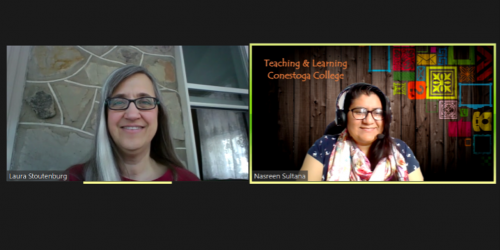
Creating Class Guidelines with Students
You and your students are engaged in a collaborative journey toward the goal of successful learning. This teaching tip suggests ways to create guidelines together with your students in order to create an inviting atmosphere that supports learning for everyone in the class.

“Wind Direction Compass” by holytoastr is licensed under CC BY-NC-SA 2.0
What is the purpose of class guidelines?
The purpose of class guidelines are to create a positive learning environment and foster mutual respect among participants.
Creating a context of a warm welcome
Whether in-class, in an online synchronous setting, or engaged in hybrid learning, students in your course will benefit from guidance in understanding the etiquette and practices conducive to everyone’s learning. Why co-create guidelines with students? Your learners will be far more invested in following guidelines that they have helped to create or have discussed as a class. Classroom norms should be established as early as possible to set a positive tone for the rest of the course.
The academic success of a diverse student body begins with a sense of inclusion and security. Students who feel welcome and safe in their classes will be one crucial step closer to the kind of engagement needed for successful learning (Cox and Strange, 2016, p. 216). A warm welcome takes the form of ice breaking activities (see Icebreakers), but welcome is also reflected in positive language and in attention paid to making sure expectations are clear.

Fostering mutual respect
Respect is the most basic ingredient to make the effective interaction between teacher and learners possible. The duty to ensure mutual respect falls to you as the teacher. Time spent in the first few weeks creating a set of mutually agreed upon guidelines for conduct can help set a tone of mutual respect. Any member of the class may ask to return to these guidelines in later weeks if behavioural issues arise (Jackson, 2019, P. 38).
Ways to co-create guidelines
Faculty and students engaged in online synchronous learning should refer to a college-wide guidelines, Student Expectations for Online Engagement, which is available on the Student Affairs webpage. However, co-creating guidelines for class conduct is likely to promote a shared understanding of expectations for conduct, as well as mutual “buy in” to ensure they are followed.
Here are some sample ways to generate a list of ways to generate classroom conduct guidelines together with your students.
Develop a behaviour guidelines poster
If you are online synchronous or hybrid, you can use the Zoom whiteboard (synchronously) or a tool such as Padlet, (linked to Week 1 or 2 of eConestoga), or a shared OneDrive document, to have students brainstorm behaviours and characteristics that will enhance their learning. They can include positive behaviours to encourage and undesirable behaviours to avoid. You can take a picture of the poster and post it on eConestoga. If there are behaviours you have noticed in the first Zoom or Teams session, such as smoking while visible on camera, you can take this opportunity to suggest that students who are eating or smoking mute their videos so as not to distract others from learning. Have the students “sign” the document and then post it to eConestoga. This same activity in an in-class environment can be carried out using the whiteboard or sticky notes on a wall of the classroom.
Create a “What do you need” brainstorm
Another activity consists of displaying three questions for students to consider. You can use a whiteboard (in-class or on Zoom), a mentimeter, a shared OneDrive document, or an eConestoga Discussion Forum for this activity.
For your success in this class,
| What do you need from yourself? | What do you need from each other? | What do you need from me? |
Discuss the collective results to ensure that everyone agrees with the generated ideas. You can then collect the resulting lists and post them on eConestoga in an accessible format as the classroom protocol for the semester.
Use the ROPES guidelines
If you think that your students might need some guidance describing the behaviour and environments that support their learning, you may want to begin with a ready-made set of guidelines . At the beginning of class, these key works may be posted and defined. Then, have students discuss what each item means to them. An acronym I have used in the past is ROPES.
| Acronym | Possible comments for each |
| Respect | (For each other – this includes respect for diversity. What does that mean to you?) |
| Openness | (To new ideas and ways of learning – how can we be open to new things?) |
| Participation | (Participate in learning activities – with the option of a pass, no questions asked.) |
| Equity | (Fair does not always mean exactly the same. The goal is everyone’s success. What does equity mean to you?) |
| Support | (Groups which cooperate outperform groups which do not. We will all do better if we support each other in learning. What are reasonable expectations of support?) |
The advantage of an acronym is that if counter-productive behaviours arise later in the semester, you only have to say “remember the ropes” without singling students out, and if you are consistent, it can be a simple tool to help keep learning on track.
Guideline examples
What are some of the guidelines you hope to elicit from your students? Here are examples shared by faculty from previous classes:
Basic Guidelines
- Don’t talk while the teacher is talking
- Don’t talk while another student is talking
- Participate in the class activities.
- Keep mics muted during Zoom class
- Eliminate background distractions (when possible!)
- Be on time for class meetings
- Come prepared to participate – complete pre-class activities
Guidelines for Interaction
- Be positive
- Be respectful
- Be a good listener
- Treat group members equally
- Communicate in the same language
- Co-operate
- Consider all ideas
- Learn from each other
- Help each other
- Active participation
- Respect cultural differences
Guidelines for Assignments
- Discuss issues openly
- Submit the work on time
- Follow instructions
- Stick to meeting deadlines
- Don’t share assignments amongst each other.
References
Cox, D. G. H., & Strange, C. C. (2016). Serving Diverse Students in Canadian Higher Education. Montreal: MQUP. Retrieved from https://search.ebscohost.com/login.aspx?direct=true&db=nlebk&AN=1290381&site=eds-live&scope=site
Jackson, R. (2019). RESPECT from Day One. Educational Leadership, 77(1), 36–41. Retrieved from https://search.ebscohost.com/login.aspx?direct=true&db=tfh&AN=139511642&site=eds-live&scope=site
Stoutenburg, L. & Sultana, N. (2020). The First Two Weeks: Ice Breakers in Remote Learning Environments. Retrieved on May 5, 2020 from https://tlconestoga.ca/ice-breakers-in-a-remote-environment/






2 Responses